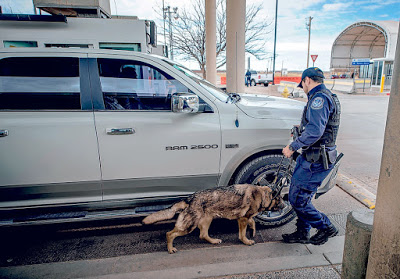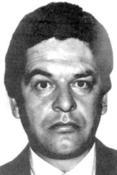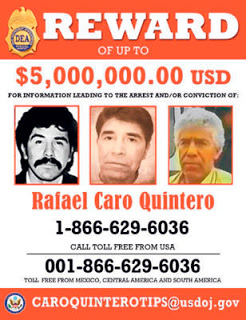

| Online: | |
| Visits: | |
| Stories: |

| Story Views | |
| Now: | |
| Last Hour: | |
| Last 24 Hours: | |
| Total: | |
The Cartels Next Door (last of a series of 6): Can we stem the drug tide?
Thanks to BB reader Judeg99 for the heads-up on this story
Previous in 6 part series;
Part One: Cartels' Roots Run Deep in N.M.
Part Two; Far from dead, Juárez Cartel flexes its muscles
Part Three: ‘Mayor of Mexico’ ran a slick operation
Part Four; Mexican drug lords corner meth market
Part Five: Despite cartel ban on local sales, Juárez meth use surges
By Mike Gallagher / Journal Investigative Reporter
 |
| Customs and Border Protection officer uses a drug-sniffing dog at the Santa Teresa port of entry. (Roberto E. Rosales/Journal) |
Over the Christmas holidays, seven people were charged with transporting more than 52 pounds of methamphetamine in four separate incidents in and around Albuquerque.
There was a time when any one of those arrests would have been big local news here, even though all the drugs were destined for Oklahoma City, Columbia, S.C., and other cities.
But arrests and seizures are so commonplace, and drugs so ubiquitous, they scarcely moved the media interest meter.
It’s not as though the arrests were inconsequential.
Federal agents say that by intercepting drugs carried by “mules” at the Amtrak and Greyhound stations or during traffic stops on I-40, they are having an impact on the country’s drug problem. The 52 pounds of methamphetamine seized on Dec. 28 and 30 represent more than 23,000 grams of meth that would have been sold on the streets of New York for more than $2.3 million.
But did these busts make much of an impact on the supply of methamphetamine wreaking havoc coast to coast? Not even a dent.
Heroin and methamphetamine smuggled from Mexico into the United States by Mexican cartels are more abundant, cheaper and more powerful than ever. And the cartels provide plenty of marijuana as well, although the price is a little higher than it was a few years ago.
In addition, the Mexican cartels have added fentanyl – a cheap synthetic opioid 100 times more powerful than morphine – to the mix of illicit drugs smuggled into the United States.
While Mexico has been a frequent target of President Donald Trump, both governments have a huge challenge in trying to rein in the cartels.
Most drugs enter the United States through the ports of entry, and Trump’s suggestion that a “wall” along the border will curb drug trafficking has been met with some skepticism from within his own political party.
“There are a lot of ways to defeat the wall,” Rep. Steve Pearce, R-N.M., said in an interview last week. “They can fly over it with light aircraft using GPS on bundles of drugs. The cartels have great tunnelers. They’ve had tunnels with traffic in both directions.”
And the cartels have the money to support those efforts.
“Transnational organized crime groups get to a size where they overwhelm the central governments,” said Bruce Ohr, associate deputy attorney general at the U.S. Department of Justice.
“They have more money than their central governments,” Ohr said in an interview. “Those groups are a threat to the United States. It is a global problem, and one we worry about.”
Positive steps
Ohr serves as the director of the Organized Crime and Drug Enforcement task forces, as well as director of the Attorney General’s Organized Crime Council. Ohr also deals with his counterparts across the globe.
He can sound like a prophet of doom and them pivot to point out progress around the world on combating international drug trafficking.
In a December interview, he pointed out a number of positive developments.
Among them:
• Despite changes in leadership, Mexico is continuing to overhaul its criminal justice system to make it more effective in combating drug cartels.
• Mexico has raided an average of 240 methamphetamine laboratories a year and forced the cartels to move some methamphetamine operations into Central America because of police pressure.
• Mexico has extradited cartel leaders, including Joaquín “El Chapo” Guzmán Loera, the head of the Sinaloa Cartel, to the United States. Guzmán, who was brought to the United States in January, will face trial in New York on charges related to running one of the world’s biggest drug organizations.
• China has worked with U.S. law enforcement to restrict the production and trade of precursor chemicals used to make methamphetamine and in the production of fentanyl and fentanyl-type drugs.
• More countries, including China, are working with U.S. law enforcement on organized crime money laundering investigations.
But Ohr said international cooperation isn’t always smooth.
There are a lot of substances that are still legal in China, but that is changing, he said. And “in Mexico, there has been a lot of progress, but corruption is still a concern,” he said.
Agent tortured
Rafael Caro Quintero is a problem in U.S. law enforcement relations with Mexico.
Quintero is supposed to be in a Mexican federal prison.
He’s not.
Quintero, Miguel Ãngel Félix Gallardo and Ernesto Fonseca Carrillo founded the Guadalajara Cartel in the early 1980s. Gallardo was chairman of the board. Fonseca represented the old guard and Quintero represented the up-and-comers.
He also is believed to be the man behind the murder of U.S. Drug Enforcement Administration Special Agent Enrique “Kiki” Camarena in February 1985.
Camarena, who was assigned to the DEA office in Guadalajara, led the Mexican military to the Rancho El Bufalo in the Mexican state of Chihuahua, where between 5,000 and 10,000 tons of marijuana was destroyed in late 1984.
It was Quintero’s marijuana operation
 |
| Enrique “Kiki” Camarena |
A few months later, Camarena was abducted, taken to a cartel ranch and tortured for more than 30 hours.
His abductors included members of the Mexican Federal Security Directorate, a police agency that was eventually broken up because it was so corrupt.
Camarena’s torture and interrogation were recorded on audiotape that was recovered by U.S. law enforcement. His skull, nose, jaw and cheekbones were broken with a tire iron. His torturers broke his ribs. They used a cattle prod on him.
Camarena’s body was discovered in March 1985, a month after his abduction.
When American DEA agents cornered Quintero, Mexican police turned and held the agents at gunpoint while Quintero boarded an airplane and escaped. He was later arrested in Costa Rica by DEA agents, returned to Mexico and was sentenced to 40 years in prison.
Mexico would not extradite him to stand trial in the U.S. for Camarena’s murder, partly because Quintero faced the death penalty.
He was released, without any announcement, in August 2013 after serving 28 years
The Mexican government never notified the United States.
The extradition request for Quintero has been ignored.
Quintero has written the Mexican press that he is innocent of the charges of killing Camarena and is not involved in drug trafficking.
The U.S. Treasury Department has publicly linked him to laundering drug money in 2014 and again in 2016.
Quintero is believed to be living in southern Chihuahua, where the Juárez Cartel has expanded poppy production in recent years.
Partial victories
There are no quick answers, but there may be hope.
Associate Deputy Attorney General Ohr points to what can be considered past successes ‒ – the destruction of the large Colombian cocaine cartels and the defeat of the Italian Mafia families in New York City.
Neither was a complete victory. There are Colombian cartels dealing cocaine today. And the Italian Mafia still exists in New York.
But they are shadows of the powerful organized crime syndicates they were decades ago.
The Medellin Cartel was a legitimate threat to the Colombian government, killing police, prosecutors, judges and legislators.
The five Mafia families in New York had their hands in almost every aspect of life in the New York area, from drugs to garbage hauling to construction to food distribution.
“It took sustained law enforcement efforts,” Ohr said.
In taking on the Mafia families, the Department of Justice developed the Organized Crime Drug Enforcement Task Force system.
It took money from all federal law enforcement agencies – to get them to cooperate – and pooled the money to pay for long-term investigations.
The DOJ used federal racketeering statutes and money laundering laws.
“We were able to knock La Cosa Nostra down to size,” he said.
In Florida, U.S. law enforcement used many of the same tools to help Colombian law enforcement attack the Medellin Cartel and later the Cali Cartel.
“These were huge, intractable problems,” Ohr said. “It was messy at times. It wasn’t easy, but the existing drug networks are nowhere near as powerful as they once were.”
“I think Colombia might be the best example of what we may be able to do in combating the criminal networks in Mexico,” he said.
Whether Mexico would willingly accept the full public participation by American law enforcement is another question.
Demand drives it
 |
| U. S. Attorney Damon Martinez |
In New Mexico, Damon Martinez has been running the U.S. Attorney’s Office for the past four years.
From his perspective, combating drug trafficking organizations is less difficult than fighting the drug abuse problem.
From his perspective, combating drug trafficking organizations is less difficult than fighting the drug abuse problem.
New Mexico Attorney General Hector Balderas recently launched initiatives to combat drug abuse at the state level.
The State Pharmacy and Medical boards have toughened regulations on prescribing painkilling drugs.
And other state programs aimed at reducing the harm caused by the drugs, like making heroin overdose antidotes available to police, have helped reduce the state’s rate of overdose deaths.
But as heroin overdose deaths have declined slightly, methamphetamine overdose deaths have increased. Some consider a meth habit harder to break than addiction to heroin.
But they both fuel crime as addicts rob, steal and sell drugs to buy more drugs.
Albuquerque Deputy Police Chief Eric Garcia said drugs are directly related to the overwhelming number of crimes here and that crimes by people high on meth tend to be more violent and horrific than others.
Still, law enforcement has responded.
“We have limited resources; we have to direct our resources where they will make a difference,” Martinez said. “We targeted violent criminals in the community through the worst of the worst. We targeted pharmacy robberies.
“Our law enforcement efforts have to evolve,” he said. “I think we can counter each and every move the cartels and traffickers make.
“We can’t give up on it.”
By the numbers
1,989 miles – The length of Mexico’s border with the U.S. from the Pacific Ocean to the Gulf of Mexico.
48 – Number of border crossings.
330 – ports of entry, including railroad crossings.
More than 74 million – The number of personal vehicles that used the ports of entry to cross the border in 2015.
More than 41 million – The number of pedestrians that crossed the border in 2015.
5.5 million – The number of tractor-trailers that legally crossed the border in 2015.
Mexico is the United States’ third-largest trading partner, behind Canada and China.
$172 billion – The value of exports from the U.S. to Mexico in 2015, more than twice what the U.S. sent to China.
More than $218 billion – The value of imports from Mexico to the U.S. in 2015. Trade with Mexico accounts for 14.5 percent of all U.S. foreign trade.
Source: http://www.borderlandbeat.com/2017/02/the-cartels-next-door-last-of-series-of.html



